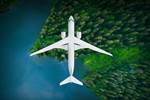RTX joins Sustainable Flight Demonstrator project team
Selected by Boeing, RTX business units Pratt & Whitney and Collins Aerospace will be supporting the X-66A aircraft dedicated to aviation decarbonization.
RTX (formerly Raytheon Technologies, Arlington, Va., U.S.) has been selected by Boeing (Arlington, U.S.) as a collaborator on the X-66A flight demonstrator, part of NASA’s (Washington, D.C., U.S.) Sustainable Flight Demonstrator (SFD) project. Two RTX business units, Pratt & Whitney and Collins Aerospace, will support Boeing with Pratt & Whitney GTF engines, and Collins composite nacelles and engine accessories. Pratt & Whitney and Collins will also support ground and flight tests, slated to start in 2028.
The SFD is part of NASA’s broader Sustainable Flight National Partnership, which is dedicated to developing the technologies needed to achieve net-zero CO2 emissions for commercial aviation. Boeing’s X-66A program is focused on developing the transonic truss-braced wing (TTBW) concept, which could enable significant improvements in fuel efficiency and reduced emissions for next generation single-aisle aircraft (read more about the project here).
The GTF engine’s geared fan architecture, delivers high fuel efficiency and sustainability benefits for single-aisle aircraft; Pratt & Whitney also hinted at engine upgrades using ceramic matrix composites (CMC) in 2017. With up to 20% better fuel efficiency, GTF engines have helped airlines save more than 1.4 billion gallons of fuel and over 14 million metric tons of CO2 emissions since entering service in 2016. GTF engines are certified to operate with sustainable aviation fuel (SAF) and offer up to a 75% reduction in aircraft noise footprint compared to previous generation engines.
Collins’ nacelles consist of lightweight and durable composite and metallic materials that encase the engine and serve many functions, including safeguarding the engine, controlling airflow, reducing noise and facilitating thrust reversal for deceleration during aircraft landings. In addition, Collins provides the control system components for the GTF engine, including heat exchangers, the integrated fuel pump and control, the air turbine starter and electronic controls.
“The learnings from the Sustainable Flight Demonstrator, X-66 and the partnership with NASA are important elements in the industry’s efforts to decarbonize aviation,” Dr. Todd Citron, Boeing’s CTO, reiterates. “We’re grateful for the support from RTX on this critical effort.”
Pratt & Whitney and Collins are also collaborating with NASA on other Sustainable Flight National Partnership projects, including Hybrid Thermally Efficient Core (HyTEC) and Hi-Rate Composite Aircraft Manufacturing (HiCAM).
Related Content
-
Combining multifunctional thermoplastic composites, additive manufacturing for next-gen airframe structures
The DOMMINIO project combines AFP with 3D printed gyroid cores, embedded SHM sensors and smart materials for induction-driven disassembly of parts at end of life.
-
Plant tour: Albany Engineered Composites, Rochester, N.H., U.S.
Efficient, high-quality, well-controlled composites manufacturing at volume is the mantra for this 3D weaving specialist.
-
Plant tour: Middle River Aerostructure Systems, Baltimore, Md., U.S.
The historic Martin Aircraft factory is advancing digitized automation for more sustainable production of composite aerostructures.
















